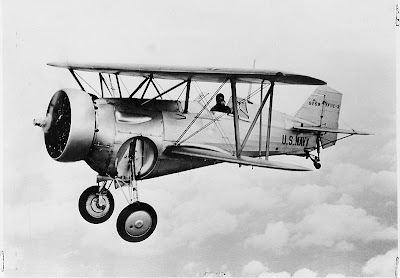 |
| XF11C-2 Test Flight, November 4, 1932 |
Introduction
The Curtiss F11C Goshawk was a 1930’s biplane that served with the United States Navy. Though it only saw limited successes, it was part of a long line of Curtiss ‘Hawk’ aircraft, built by the Curtiss Aeroplane and Motor Company for the United States military.
Development
In April of 1932, when the Curtiss Company was planning the Model 35B, the United States Navy contracted with Curtiss for an improved version of the Model 34C, or F6C, as the F11C. Several changes were made, including the use of the 600hp Wright R-1510-98 radial engine, single-leg cantilever main undercarriage units, and a slight increase in interplane gap, metal covered control surfaces (as opposed to fabric), and an armament of two 7.62mm Browning machine guns and a hardpoint under the fuselage for a 474lb bomb or a drop tank.
Curtiss designed the aircraft, designated by the company as the Model 64 ‘Goshawk’, while the USN designated it XF11C-1. The aircraft was made of fabric-covered metal framing, and had the wing cell structure of the YP-23, and was delivered in September of 1932.
Before ordering the XF11C-1, the USN had bought a company-owned Model 64A demonstrator, with a Wright R-1820-78 Cyclone, slightly longer main undercarriage legs, and wheels that had low pressure tires, a tailwheel instead of a tailskid, fabric-covered tail control surfaces, and provision for underwing racks for light bombs in addition to the fuselage hardpoint. Flight trials of this XF11C-2 showed a need for some minor changes, and it was regarded as the prototype for the F11C-2, twenty-eight of these being ordered as fighter-bombers (or as the Navy would have it, bomber-fighters) on October 18, 1932. Deliveries began the following February, and were completed in May of 1933.
From March 1934 onwards, the aircraft was revised with a semi-enclosed cockpit and several other modifications before it was designated BFC-2 (BF standing for Bomber-Fighter). The last aircraft in the XF11C-2 contract was converted into the XF11C-3, with the more powerful Wright R-1820-80 engine, and a hand-cranked retractable landing gear.
 |
| XF11C-3 Test Flight |
Operational History
The only USN units to operate the F11C were VF-1B and VB-6. VF-1B, the famous “High Hat Squadron” was assigned to the USS Saratoga. In March of 1934, when F11C’s were renamed BFC’s, they were renumbered as VB-2B, and subsequently as VB-3B, and used BFC-2’s until February of 1938. VB-6 never actually embarked on their carrier, the USS Enterprise, while using BFC aircraft.
The F11C produced several export versions, known as Hawk I, Hawk II, and Hawk III. The Hawk II, basically a modified XF11C-2, was fitted with a 710hp Wright R-1820F-3 Cyclone radial engine, and carried 94 gallons of fuel, while the Hawk I only carried 50 gallons. Both carried the same armament as the F11C-2. The Hawk II was exported in quantity to Turkey, the first customer who ordered 19 on August 30, 1932. Columbia ordered theirs in October of the same year, also receiving twenty-six versions with twin-floats. The Columbian’s used their Hawk II’s and float-equipped F11C-2’s in the Columbia-Peru War, 1932-33. Nine Hawk II’s were sold to Bolivia, three of which could change between wheels and floats. Four aircraft were sold to Chile, fifty-two to China, four to Cuba, two to Germany, and one to Norway. Twelve were also sold to Thailand, who also obtained a license and built fifty of them locally, designating them as Fighter Type 10.
Variants
XF11C-1 (Model 64): The first prototype, derived from the Curtiss F6C Hawk
XF11C-2 (Model 64A): The second prototype; later redesignated XBFC-2
F11C-2 (Model 64A): The production version; later redesignated BFC-2; 28 built.
XF11C-3 (Model 67): A single F11C-2 fitted with a retractable undercarriage, and using a 700hp Wright R-1820-80 radial.
BF2C-1 Goshawk (Model 67A): Production version of the XF11C-3; 27 built.
Hawk II (Model 65): Export version of the XF11C-2; 126 built, 32 as floatplanes. Exported to Bolivia, Chile, China, Columbia, Cuba, Germany, Norway, Thailand, and Turkey.
Hawk III: Export version of the BF2C-1 with a 770hp Wright R-1820-F53 radial; 137 built; exported to Argentina, China, Thailand, and Turkey.
Hawk IV (Model 79): Export version utilizing a 790hp Wright R-1820-F56 radial; one built.
Specifications
F11C-2/BFC-2
Length: 22ft 7in
Height: 9ft 8.65in
Wingspan: 31ft 6in
Wing Area: 262 sq. ft.
Empty Weight: 3,037lb
Maximum Weight: 4,132lb
Powerplant: 1x 700hp Wright R-1820-78 Cyclone air-cooled radial engine
Maximum Speed: 202mph
Range: 572 miles; 286 miles with maximum payload
Ceiling: 25,100ft
Armament: 2x 7.62mm M1919 Browning machine guns in forward fuselage
Stores: 1x 474lb bomb under fuselage or 2x 120lb bombs, one under each wing, or 1x 50 gallon drop tank under fuselage
Sources:
www.avaiastar.org
www.rtaf.mi.th
www.warbirdsresourcegroup.org
www.wikipedia.org

No comments:
Post a Comment